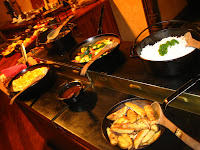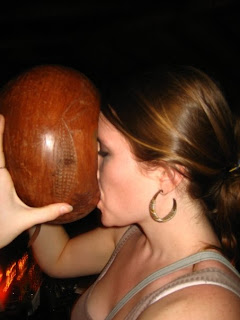There have been some changes since you last heard from me. Namely, I went vegan. What? How does a self-proclaimed cow-loving carnivorous culinary voyager swear off nearly half the world’s ingredients? Suppress your shock and awe, folks. Before you drop your newspaper and give up on me forever, let me just say—I’ll be eating all things animal for the sake of this column (or at least that’ll be my excuse if PETA ever comes knowing at my door).
 This line was over an hour long when I visited on Labor Day. Call it masochistic, call it crazy—just make sure you bring some entertainment. I came armed with a crossword puzzle while the ladies behind me brought Pinkberry, proving that you can have dessert before dinner. After the first half hour, you start catching smells from the open kitchen, then you round the corner and it hits like an epiphany—THIS is why I’m waiting in this line.
This line was over an hour long when I visited on Labor Day. Call it masochistic, call it crazy—just make sure you bring some entertainment. I came armed with a crossword puzzle while the ladies behind me brought Pinkberry, proving that you can have dessert before dinner. After the first half hour, you start catching smells from the open kitchen, then you round the corner and it hits like an epiphany—THIS is why I’m waiting in this line.An assembly line comes into view, where practiced sausage stylists adorn dogs with every topping imaginable. Sour cream? Ok! Melt-in-your-mouth pastrami? Sure thing. Strikingly adept at their craft, these ladies ladle chili and sling onion rings as if no one was watching. Mind you, they could count on at least twenty salivating faces staring back at them, should they choose to look up.

The menu has 14 regular hot dogs, five special dogs and 12 super special dogs. Most hover around four dollars, though many are cheaper. Only one exceeds six bucks, the Three Dog Night, but you get your money’s worth with three hot dogs wrapped in a giant tortilla, three slices each of cheese and bacon, chili and onions. Other super specials include the Mulholland Drive dog, the Martha Stewart dog and the Lord of the Rings dog—a ten-incher encircled by onion rings, nested in a bun and topped with BBQ sauce.

Pink’s is known for their ten-inch dogs that snap when you bite into them. Unfortunately, their Patt Morrison vegan Baja Veggie dog does not snap. I tested it out, thinking Mr. and Mrs. Pink wouldn’t put it on the menu if it wasn’t delicious. I did lick the guacamole off the limp, lifeless imposter, but I couldn’t bring myself to eat the thing itself. The bacon chili cheese dog, on the other hand, did not disappoint, and the ridiculously cheap sides helped, too. This is the only place I’ve encountered willing to slop chili onto tortilla chips and for that, they have my respect.
While I unfortunately have a threshold for grease, I’m already planning my next visit to Pink’s. I’ll need to try a plain hot dog to experience the famous snap. I’m also looking forward to cozying up with the Mushroom Swiss dog. I also can’t wait to try that pastrami, though that’s not exactly true—I can wait, and I will wait, however long the line is that day.
For a full menu, visit www.pinkshollywood.com
 My trip to Moyo may have fallen under the glamorized, slightly impersonal category, but I enjoyed it nonetheless. In my ranking of these types of establishments, next in line is the Africa Cafe. More expensive than Moyo and located in the heart of downtown Cape Town, this yellow stucco building is bubbling over with kitsch and folk art, chandeliers made of empty bottles and beads clanking overhead as you climb the stairs to any of the country-themed dining rooms. I am not sure which country I was seated in, but the Winter 2008 menu was painted on the side of a ceramic pitcher and the colors threatened to overwhelm. Luckily, I have come to positively associate this over-saturation of hues with this charming continent and it did not bother me. I could see how some might find it jarring, though.
My trip to Moyo may have fallen under the glamorized, slightly impersonal category, but I enjoyed it nonetheless. In my ranking of these types of establishments, next in line is the Africa Cafe. More expensive than Moyo and located in the heart of downtown Cape Town, this yellow stucco building is bubbling over with kitsch and folk art, chandeliers made of empty bottles and beads clanking overhead as you climb the stairs to any of the country-themed dining rooms. I am not sure which country I was seated in, but the Winter 2008 menu was painted on the side of a ceramic pitcher and the colors threatened to overwhelm. Luckily, I have come to positively associate this over-saturation of hues with this charming continent and it did not bother me. I could see how some might find it jarring, though.  Other sides included Congolese spinach and Egyptian
Other sides included Congolese spinach and Egyptian  We arrived midday and were almost immediately seated in a dining room lined with at least 30 djembes and lighting fixtures made of kudu horns and ostrich eggs. The buffet lunch featured a hearty and complex bobotie in a charming little iron pot—in case I haven't explained yet, bobotie is made by mixing ground beef with raisins and sweet spices, then topped with an egg custard and served over yellow rice. It quickly became one of my favorite South African dishes. Lalibela opened me up to a new world of bobotie, though, by serving it with condiments like banana slices, coconut shavings, cucumber yogurt salsa, and chutney. A fruit salad, parblended vegetable soup, and vegetable salad bar were also available, but I was especially blown away by the dessert options—camembert, brie, and bleu cheese on a wood block with preserved figs and walnuts, in addition to miniature lemon pies and mint-Amarula phyllo tarts.
We arrived midday and were almost immediately seated in a dining room lined with at least 30 djembes and lighting fixtures made of kudu horns and ostrich eggs. The buffet lunch featured a hearty and complex bobotie in a charming little iron pot—in case I haven't explained yet, bobotie is made by mixing ground beef with raisins and sweet spices, then topped with an egg custard and served over yellow rice. It quickly became one of my favorite South African dishes. Lalibela opened me up to a new world of bobotie, though, by serving it with condiments like banana slices, coconut shavings, cucumber yogurt salsa, and chutney. A fruit salad, parblended vegetable soup, and vegetable salad bar were also available, but I was especially blown away by the dessert options—camembert, brie, and bleu cheese on a wood block with preserved figs and walnuts, in addition to miniature lemon pies and mint-Amarula phyllo tarts. Dinner was enormously packed with springbok stew, cheesy cauliflower, steamed veggies, rice with gravy, multiple salad platters, potato wedges, and a meringues drenched in some gourmet cherry pie filling. No, thank you, I will not be needing an after-dinner aperitif. I might pass out at this table, actually.
Dinner was enormously packed with springbok stew, cheesy cauliflower, steamed veggies, rice with gravy, multiple salad platters, potato wedges, and a meringues drenched in some gourmet cherry pie filling. No, thank you, I will not be needing an after-dinner aperitif. I might pass out at this table, actually.












